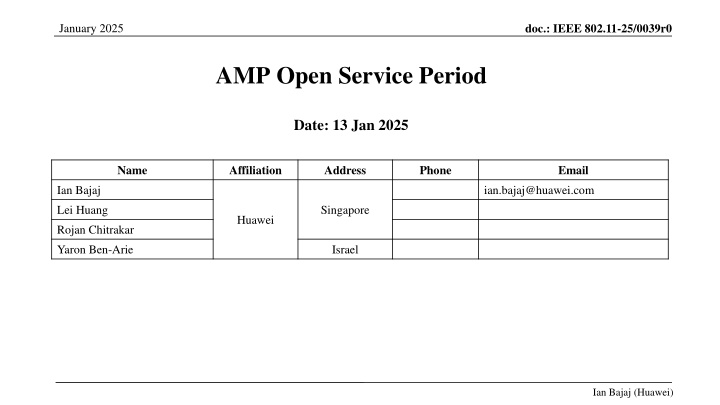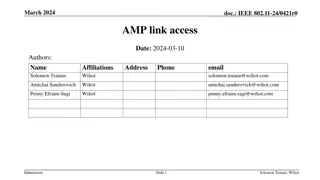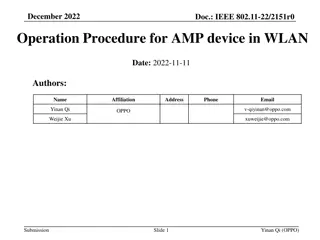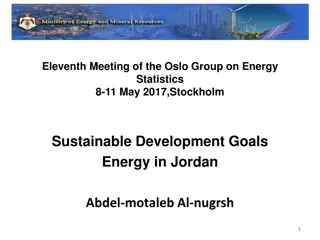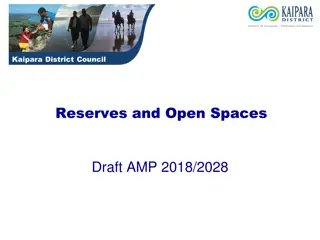AMP Open Service Period for Energy-Efficient Communication
This document discusses the concept of an AMP Open Service Period (SP) for energy-efficient communication in IEEE 802.11 networks. It explores the limitations of traditional power management schemes for AMP STAs and presents a new approach to save power by defining specific SPs for communication between AMP STAs and APs. The analysis demonstrates significant power savings for duty-cycled AMP STAs operating within agreed SPs. Various simulation parameters and benefits of implementing AMP SPs are covered in detail.
Download Presentation

Please find below an Image/Link to download the presentation.
The content on the website is provided AS IS for your information and personal use only. It may not be sold, licensed, or shared on other websites without obtaining consent from the author.If you encounter any issues during the download, it is possible that the publisher has removed the file from their server.
You are allowed to download the files provided on this website for personal or commercial use, subject to the condition that they are used lawfully. All files are the property of their respective owners.
The content on the website is provided AS IS for your information and personal use only. It may not be sold, licensed, or shared on other websites without obtaining consent from the author.
E N D
Presentation Transcript
doc.: IEEE 802.11-25/0039r0 January 2025 AMP Open Service Period Date: 13 Jan 2025 Name Affiliation Address Phone Email Ian Bajaj ian.bajaj@huawei.com Lei Huang Singapore Huawei Rojan Chitrakar Yaron Ben-Arie Israel Ian Bajaj (Huawei)
doc.: IEEE 802.11-25/0039r0 January 2025 Background Several power management schemes describing duty-cycled operations for legacy STAs, such as PS- Poll, Beacon-based, TWT may not be applicable for AMP STAs as: AMP STAs cannot decode 802.11 frames Heavy MAC procedures or several frame exchanges required for setup, that do not apply to energy constraint AMP STAs AMP STAs may not have an Active mode, i.e. they cannot guarantee transmission at a specific time (without a battery source), and may always be in a power save mode Duty cycle operation for AMP STAs have been presented in [1] to represent windows that the AMP STA will receive DL AMP trigger from an AP, and otherwise sleep. In this contribution, an AMP Service Period (SP) refers to the time window where an AMP STA listens for AP DL and/or transmits UL packets to an AP. This may be considered as an AMP adaptation of TWT. The purpose of this contribution is to provide a simple means to enable AMP STAs to save significant power when operating in an agreed SP. Benefits of an AMP SP: Conservation of harvested energy at the AMP STA Resource scheduling at the AP Deterministic control of Energizers to supply RF EH to AMP STAs to support the duty cycle of the agreed SPs Ian Bajaj (Huawei) Slide 2
doc.: IEEE 802.11-25/0039r0 January 2025 Analysis of Power Saving with AMP SP Simulation Parameters: Clock power consumption: 510pW[2][3] Idle Power consumption: 0.1uW [4] Channel sensing (CS) power consumption: 10uW [4] Channel sensing on/off duration: 5ms/100ms Minimum wake duration in SP: 5ms ???? ????? ??? ???,???? SP Interval 100ms 1s 1min 10min 1hr ????? ???= (????+?????) ??????? ????? ???= ??? ???+ ????? ???? ??????? ?????/(???+ ????) ???????: duty cycle ratio, ???: energy consumed by AMP STA in SP, ???: energy consumed by AMP STA performing CS Power Saving: 1.7mJ Analysis: Duty-cycled AMP STAs benefit from power savings in the order of mJs operating in a scheduled AMP SP for a duty-cycle ratio greater than that random CS AMP STAs Ian Bajaj (Huawei) Slide 3
doc.: IEEE 802.11-25/0039r0 January 2025 AMP Open Service Period (1/2) An AP can define an Open Service Period (O-SP) that indicates pre-determined windows that the AP will gain a TXOP for any AMP STAs in its BSS, regardless of association. This may be for initial channel access for unassociated AMP STAs to enable association and future scheduled channel access, or for AMP STAs that maintain an unassociated state with an AP for contention-based channel access in all communication with the AP. An AMP SP Info frame can broadcast the SP settings which can include: the start time (absolute/relative), a minimum wake duration, and an SP interval. The set of SPs may also have an identifier to distinguish it from other ongoing SPs. Ian Bajaj (Huawei) Slide 4
doc.: IEEE 802.11-25/0039r0 January 2025 AMP Open Service Period (2/2) Absolute start time of an SP may only be applicable to AMP STAs that can maintain synchronization with TSF. A periodic AMP Beacon can carry the LSB of the AP TSF for synchronization. A relative start time maybe updated with every subsequent AMP SP Info frame prior to the start of the SP, to allow free running clocks to make necessary corrections to their drift. The minimum wake duration corresponds to the time period an AMP STA needs to monitor the channel from the start of the SP for any AP initiated trigger. If the AMP STA does not receive any frames in this period, it will return to an idle mode and resume channel sensing at the start of the subsequent SP. The AP may send out the AMP SP Info frame at a fixed periodic interval as determined by the AP The SP information can also be carried by AMP Poll (or AMP Trigger), AMP Beacon, etc. Ian Bajaj (Huawei) Slide 5
doc.: IEEE 802.11-25/0039r0 January 2025 Summary AMP Open Service Period (O-SP) was defined to support duty cycle operation for AMP STAs regardless of state of association. The benefits of AMP SP for energy conservation at the AMP STA, and in allowing scheduling of resources at the AP were discussed. An AMP frame can broadcast SP timing information to synchronize or reset the AMP STAs clocks to wake up at the intended start of the SP. Analysis was carried out to support the claim that AMP STAs in a scheduled SP may see significant power savings in the order of mJ with a duty cycle ratio greater than random channel sensing AMP STAs. Ian Bajaj (Huawei) Slide 6
doc.: IEEE 802.11-25/0039r0 January 2025 SP1 Do you agree to add the following text to TGbp SFD? IEEE 802.11bp defines a mechanism that allows AMP STAs to listen for AMP DL frames in a duty cycle manner. [Reference: 11-25/0039r0] Ian Bajaj (Huawei) Slide 7
doc.: IEEE 802.11-25/0039r0 January 2025 SP2 Do you agree to add the following text to TGbp SFD? IEEE 802.11bp defines a mechanism that allows an AMP STA to respond to AMP DL frames when in an awake state, and otherwise doze, based on the control signaling with an AP. The control signaling method is TBD. This is applicable to all AMP STAs regardless of their state of association with an AP. [Reference: 11-25/0039r0] Ian Bajaj (Huawei) Slide 8
doc.: IEEE 802.11-25/0039r0 January 2025 References [1] 11-24/1775r1, Duty-cycle AMP operation [2] L. Xu et. al., "A 510-pW 32-kHz Crystal Oscillator With High Energy-to-Noise- Ratio Pulse Injection," in IEEE Journal of Solid-State Circuits, vol. 57, no. 2, pp. 434-451, Feb. 2022. [3] 11-24/1475r2, Discussion on ultra-low power timing clock [4] 11-23/2203r1, Technical Report on support of AMP IoT devices in WLAN Ian Bajaj (Huawei) Slide 9
doc.: IEEE 802.11-25/0039r0 January 2025 Analysis of Power Saving with AMP SP Simulation Parameters: Clock power consumption: 510pW[2][3] Idle Power consumption: 1uW[4] Channel sensing (CS) power consumption: 10uW [4] Channel sensing on/off duration: 5ms/100ms Minimum wake duration in SP: 5ms ???? ????? ??? ???,???? SP Interval 100ms 1s 1min 10min 1hr ????? ???= (????+?????) ??????? ????? ???= ??? ???+ ????? ???? ??????? ?????/(???+ ????) ???????: duty cycle ratio, ???: energy consumed by AMP STA in SP, ???: energy consumed by AMP STA performing CS Power Saving: 1.54mJ Analysis: Duty-cycled AMP STAs benefit from power savings in the order of mJs operating in a scheduled AMP SP for a duty-cycle ratio greater than that random CS AMP STAs Ian Bajaj (Huawei) Slide 10
